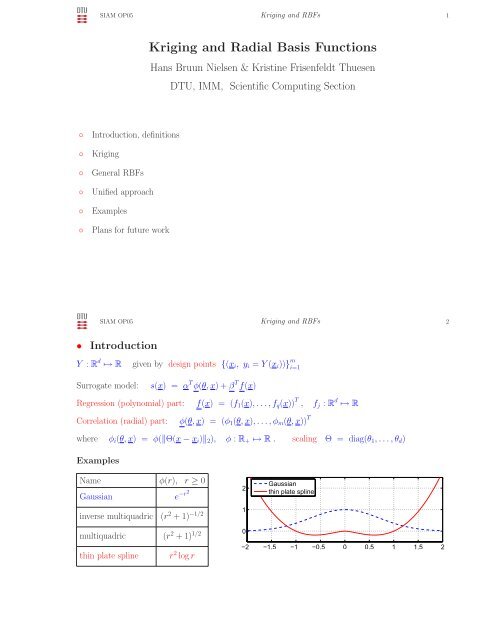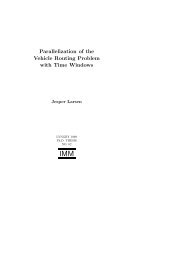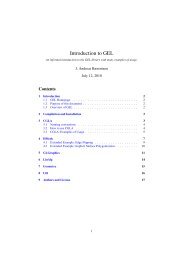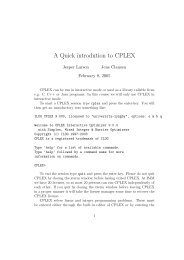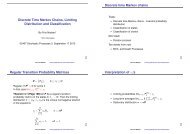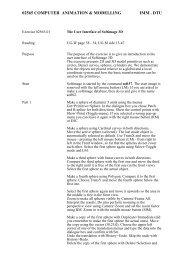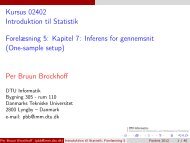Kriging and Radial Basis Functions
Kriging and Radial Basis Functions
Kriging and Radial Basis Functions
You also want an ePaper? Increase the reach of your titles
YUMPU automatically turns print PDFs into web optimized ePapers that Google loves.
SIAM OP05 <strong>Kriging</strong> <strong>and</strong> RBFs 1<strong>Kriging</strong> <strong>and</strong> <strong>Radial</strong> <strong>Basis</strong> <strong>Functions</strong>Hans Bruun Nielsen & Kristine Frisenfeldt ThuesenDTU, IMM, Scientific Computing Section◦ Introduction, definitions◦ <strong>Kriging</strong>◦ General RBFs◦ Unified approach◦ Examples◦ Plans for future workSIAM OP05 <strong>Kriging</strong> <strong>and</strong> RBFs 2• IntroductionY : R d ↦→ R given by design points {(x i ,y i =Y(x i ))} m i=1Surrogate model:s(x) = α T φ(θ,x)+β T f(x)Regression (polynomial) part: f(x) = (f 1 (x),...,f q (x)) T , f j : R d ↦→ RCorrelation (radial) part:φ(θ,x) = (φ 1 (θ,x),...,φ m (θ,x)) Twhere φ i (θ,x) = φ(‖Θ(x − x i )‖ 2 ), φ : R + ↦→ R . scaling Θ = diag(θ 1 ,...,θ d )ExamplesName φ(r), r ≥ 0Gaussiane −r2inverse multiquadric (r 2 +1) −1/221Gaussianthin plate splinemultiquadric (r 2 +1) 1/2thin plate spliner 2 log r0−2 −1.5 −1 −0.5 0 0.5 1 1.5 2
SIAM OP05 <strong>Kriging</strong> <strong>and</strong> RBFs 3InterpolationΦα + Fβ = y , Φ ij = φ j (θ,x i ), F i,: = f(x i ) Tm equations with m+q unknowns.Both in <strong>Kriging</strong> <strong>and</strong> general RBF approach: supply with F T α =0( )( ) ( )Φ F α y=(∗)F ⊤ 0 β 0Φ∈R m×mis symmetric. Full rank if the x i are distinct.F ∈ R m×q ,q
SIAM OP05 <strong>Kriging</strong> <strong>and</strong> RBFs 5• General RBFsΦ is not necessarily definite, but Powell 1 shows thata number of popular RBFs satisfysign ( v T Φ v ) = (−1) µfor all v ∈ V µ ,v≠0V µ = {v∈R m ∑: mi=1 v ip(x i )=0for any p ∈ Π µ−1 }We assume that {f j } comprises a basis of Π µ−1 .Then V µ ⊆N(F T ), the nullspace of F T . An orthonormalbasis of N can be found as N in the completeQR factorization of F ,( ) ( )RF = Q N = QR0Name φ(r), r ≥ 0 µGaussian e −r2 0inverse multiquadric (r 2 +1) −1/2 0linear r 1multiquadric (r 2 +1) 1/2 1thin plate spline r 2 log r 2cubic r 3 21M.J.D. Powell: 5 lectures on radial basis functions. Report IMM-REP-2005-03, IMM, DTU, 2005.SIAM OP05 <strong>Kriging</strong> <strong>and</strong> RBFs 6s(x) = α T φ(θ,x)+β T f(x).Φα+Fβ = ySeek α ∈ V µ ⊆N(F T ):α=Nα NN T ΦNα N +N T Fβ = N T y, (−1) µ ˜Φ αN = y NThe matrix ˜Φ =(−1) µ N T Φ N is symmetric <strong>and</strong> positive definite.The regression coefficients are found fromRβ = Q ( )T y−ΦNα N
SIAM OP05 <strong>Kriging</strong> <strong>and</strong> RBFs 7• Unified approacha ∈ R m . a = Qa R + Na N , a R = Q T a, a N = N T aAssume that y = Fβ +z, z = Nz NE [ z z T] = σ 2 NAN T , A = D˜ΦD, D = diag(˜Φ −1/2ii )A is symmetric, positive definite, <strong>and</strong> A ii =1. Valid correlation matrix.A = DC T CDBLUE:min ‖v‖ 2 2 s.t. Fβ +NDC T v = y Solution: C T v =(−1) µ D −1 N T yv,gbv ∈ R m−q has variance σ 2 I. Estimate: σ 2 = ‖v‖ 2 2/(m − q)}Assume Gaussian process: θ ∗ = argmin θ{Γ(θ) ≡ det A(θ) · σ 2(m−q) (θ)SIAM OP05 <strong>Kriging</strong> <strong>and</strong> RBFs 8Theorem: For φ(r) ∈{r, r 3 ,r 2 log r}, ω∈R + :s(ωθ,x) = s(θ,x),Γ(ωθ) = Γ(θ)Remarks:“Scalar” θ has no effect.“Full” θ : Finding θ ∗ reduces to a problem in R d−1+ instead of R d +
SIAM OP05 <strong>Kriging</strong> <strong>and</strong> RBFs 9• ExamplesY (x) =d∏e kx kcos(2kx k )k=1Educated guess: θ ∗ =(1,2,...,d) T2Test regions T of sizes 2 2 , 2 3 , 0.5 40−2Successively insert new designpoint atargmax x∈T|s(x) − Y (x)|−4−60−0.5−1−1.50.511.52SIAM OP05 <strong>Kriging</strong> <strong>and</strong> RBFs 1010 0 No scaling: θ = (1, 1)10 0 With scaling10 −210 −4Thin plate splineMultiquadricGaussian0 10 20 30 40 50 60 70 80 90 1002-D10 −210 −40 10 20 30 40 50 60 70 80 90 10010 0 No scaling: θ = (1, 1, 1)10 0 With scaling10 −1Thin plate splineMultiquadricGaussian10 −20 10 20 30 40 50 60 70 80 90 1003-D10 −110 −20 10 20 30 40 50 60 70 80 90 10010 0 No scaling: θ = (1, 1, 1, 1)10 0 With scaling10 −1Thin plate splineMultiquadricGaussian10 −210 20 30 40 50 60 70 80 90 1004-D10 −110 −210 20 30 40 50 60 70 80 90 100
SIAM OP05 <strong>Kriging</strong> <strong>and</strong> RBFs 11Data: First 25 points from Gaussian example.Use thin plate spline. θ ∗ = (1,θ ∗ 2) T10 10 Γ10 510 010 −5MSE10 −1 10 0 10 1θ ∗ = (1, 2) T (as expected)SIAM OP05 <strong>Kriging</strong> <strong>and</strong> RBFs 12MSE:under progress.Assume φ(0) ∈{0,1}.Ω 2 (x) = (−1) µ σ 2 { φ(0) + γ(x) T [ Φγ(x) − 2φ(θ,x) ]} (?)0.2Ω(x)0.2|s(x) − Y(x)|00−0.2−0.2−0.4−0.4−0.6−0.6−0.8−0.8−1−1−1.2−1.2−1.40.5 1 1.5 2−1.40.5 1 1.5 2
SIAM OP05 <strong>Kriging</strong> <strong>and</strong> RBFs 13• Plans for future work• Verifying (improving ?) the expression for Ω 2 (x)• Large scale: can explicit computation of N be avoided ?• Update the Matlab DACE package 2 to allow for general RBFs2See http://www2.imm.dtu.dk/∼hbn/dace/


